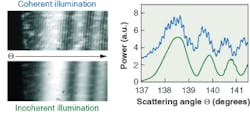OPTICAL METROLOGY: Incoherent light improves rainbow refractometry

Optical-metrology techniques benefit from the use of semiconductor lasers as bright, low-noise sources with good beam properties, attractive emission properties, small dimensions, and high wall-plug efficiencies. Because the interference effects of coherent light can limit the resolution of certain measurements, however, a bright incoherent light source (ILS) can benefit such applications as optical-coherence tomography (OCT) and secure-chaos-encryption communications.
For this reason, researchers at the Institute of Applied Physics at Darmstadt University of Technology (TUD; Darmstadt, Germany) and Sacher Lasertechnik (Marburg, Germany) have developed a novel incoherent semiconductor-laser source.1 Its use has been demonstrated in a rainbow-refractometry experiment in collaboration with the chair of fluid mechanics and aerodynamics at TUD.
The ILS relies on the nonlinear dynamic properties of an external-cavity configuration. A Fabry-Perot laser with a center wavelength of 785 nm is collimated by a lens, partially back-reflected by a mirror, and reinjected into the cavity. By setting the ratio of the physical cavity length to the optical length of the semiconductor-laser cavity to 2.5, a resonance condition is achieved between the fundamental frequency of the laser cavity and the external cavity that facilitates enhanced coupling between the longitudinal laser modes, resulting in broadband emission.
Tunable coherence
To achieve such conditions, the coherence length of the laser source can be tuned in the range of meters down to the submillimeter scale using the optical-feedback phase as the control parameter. The reported coherence length of 120 μm for this 110 mW broadband light source benefits many metrology applications in which unwanted interference effects-such as the well-known speckle phenomena-can now be avoided.
Rainbow refractometry is a noninvasive optical-measurement technique with applications in such industrial and technological processes as internal combustion engines, medicine, and agriculture. In the technique, the temperature or size of liquid droplets in a medium is analyzed by determining the angular intensity distribution of the scattered light. Interference effects between reflected and refracted light beams under coherent illumination complicate the interpretation of the intensity distribution, and thus the determination of the desired information. In contrast, when the coherence length is shorter than the diameter of the droplets, the simpler interference pattern allows for more accurate determination of the droplet size. Compared to costly pulsed laser sources or feedback-sensitive superluminescent light-emitting diodes, the ILS offers a potentially lower-cost, simpler alternative.
In the refractometry experiment, water droplets with diameters between 400 µm and 1 mm were trapped by an acoustic levitator and illuminated by collimated light from the broadband incoherent source. The image of the scattered-light distribution from the ILS was then compared to the distribution occurring when the light source was tuned to coherent emission with a 7.8 m coherence length (see figure). The smooth data distribution from the ILS enables improved determination of the droplet characteristics, and demonstrates its use in a sample metrology experiment.
“One major advantage of our ILS is its potential for optical metrology in many fields, since it allows realization of incoherent semiconductor-laser light in a broad spectral range between the UV and mid-IR,” says Michael Peil, one of the researchers. Current and future work concentrates on different laser types for realization of ILS devices in the near- and mid-IR ranges, with applications in remote sensing such as maximizing robustness and minimizing size of fiber-optic gyroscopes.
REFERENCE
1. M. Peil et al., Appl. Phys. Lett. 89, 091106 (2006).
About the Author

Gail Overton
Senior Editor (2004-2020)
Gail has more than 30 years of engineering, marketing, product management, and editorial experience in the photonics and optical communications industry. Before joining the staff at Laser Focus World in 2004, she held many product management and product marketing roles in the fiber-optics industry, most notably at Hughes (El Segundo, CA), GTE Labs (Waltham, MA), Corning (Corning, NY), Photon Kinetics (Beaverton, OR), and Newport Corporation (Irvine, CA). During her marketing career, Gail published articles in WDM Solutions and Sensors magazine and traveled internationally to conduct product and sales training. Gail received her BS degree in physics, with an emphasis in optics, from San Diego State University in San Diego, CA in May 1986.